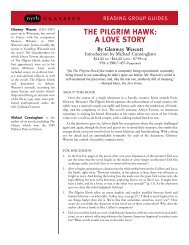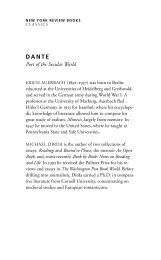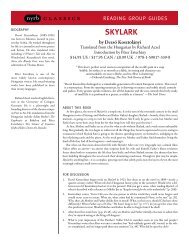Renoir, My Father Introduction - The New York Review of Books
Renoir, My Father Introduction - The New York Review of Books
Renoir, My Father Introduction - The New York Review of Books
You also want an ePaper? Increase the reach of your titles
YUMPU automatically turns print PDFs into web optimized ePapers that Google loves.
RENOIR,<br />
MY FATHER<br />
JEAN RENOIR<br />
INTRODUCTION BY<br />
ROBERT L. HERBERT
NEW YORK REVIEW BOOKS<br />
CLASSICS<br />
RENOIR, MY FATHER<br />
JEAN RENOIR (1894–1979), the son <strong>of</strong> the painter Auguste<br />
<strong>Renoir</strong>, was born in Paris, grew up in the south <strong>of</strong> France,<br />
and served as a cavalryman and pilot during World War I. He<br />
directed his first film, La Fille de l’eau, in 1925 and followed it<br />
with many others, including his masterpieces Grand Illusion<br />
(1937) and <strong>The</strong> Rules <strong>of</strong> the Game (1939). In 1975 Jean <strong>Renoir</strong><br />
received an Academy Award for his lifetime contribution to<br />
the cinema.<br />
ROBERT L. HERBERT, after a long career at Yale, is now Andrew<br />
W. Mellon Pr<strong>of</strong>essor Emeritus <strong>of</strong> Humanities at Mount Holyoke.<br />
He is a member <strong>of</strong> the American Academy <strong>of</strong> Arts and Sciences<br />
and the American Philosophical Society, and has been named<br />
Officier dans l’Ordre des Arts et des Lettres by the French<br />
Government. Among his books are Impressionism: Art, Leisure<br />
and Parisian Society, Nature’s Workshop: <strong>Renoir</strong>’s Writings on<br />
the Decorative Arts, and Seurat: Drawings and Paintings.
RENOIR, MY FATHER<br />
JEAN RENOIR<br />
Translated by<br />
RANDOLPH AND DOROTHY WEAVER<br />
<strong>Introduction</strong> by<br />
ROBERT L. HERBERT<br />
new york review books<br />
nyrb<br />
<strong>New</strong> <strong>York</strong>
THIS IS A NEW YORK REVIEW BOOK<br />
PUBLISHED BY THE NEW YORK REVIEW OF BOOKS<br />
1755 Broadway, <strong>New</strong> <strong>York</strong>, NY 10019, USA<br />
Copyright © 1958, 1962 by Jean <strong>Renoir</strong><br />
<strong>Introduction</strong> Copyright © 2001 by Robert Herbert<br />
All rights reserved.<br />
Library <strong>of</strong> Congress Cataloging-in-Publication Data<br />
<strong>Renoir</strong>, Jean, 1894-<br />
[Pierre-Auguste <strong>Renoir</strong>, mon père. English]<br />
<strong>Renoir</strong> : my father / Jean <strong>Renoir</strong> ; introduction by Robert Herbert ;<br />
translated by Randolph and Dorothy Weaver.<br />
p. cm.<br />
Originally published: Boston : Little, Brown, 1962.<br />
Includes index.<br />
ISBN 0-940322-77-3<br />
1. <strong>Renoir</strong>, Auguste, 1841-1919. 2. Painters—France—Biography. I.<br />
Title.<br />
ND553.R45 R42813 2001<br />
759.4—dc21<br />
2001002539ISBN 0-940322-77-3<br />
Cover painting: Pierre-Auguste <strong>Renoir</strong>, <strong>The</strong> Garden in the rue Cortot,<br />
Montmartre (detail), 1876<br />
Courtesy <strong>of</strong> the Carnegie Museum <strong>of</strong> Art, Pittsburgh; acquired through the generosity<br />
<strong>of</strong> Mrs. Alan M. Scaife<br />
Cover design: Katy Homans<br />
Book design by Lizzie Scott<br />
Printed in the United States <strong>of</strong> America on acid-free paper.<br />
10 9 8 7 6 5 4 3 2 1<br />
September 2001<br />
www.nybooks.com
INTRODUCTION<br />
IN THE spring <strong>of</strong> 1953, from his home in Hollywood, Jean <strong>Renoir</strong><br />
wrote to the publisher Bennett Cerf:<br />
I would like to attempt to give form to my own recollections<br />
<strong>of</strong> the conversations I had with my father mostly at the<br />
end <strong>of</strong> his life. I won’t quote the exact dialogue which I don’t<br />
remember, but try to give an idea <strong>of</strong> my past impressions<br />
<strong>of</strong> such meetings and <strong>of</strong> the way they influence me today.<br />
<strong>The</strong>se conversations were about anything: his past experiences,<br />
his childhood, our family, his friends, his admirations,<br />
and also very much about his suspicions regarding the fast<br />
changes in our modern world. 1<br />
<strong>The</strong> famous filmmaker was then fifty-nine, and would be sixtyeight<br />
when the book was published at the end <strong>of</strong> 1962. When he<br />
and his father began their lengthy conversations in 1915, during<br />
Jean’s long convalescences from successive wartime injuries, Jean<br />
was twenty-one, and Auguste seventy-four. <strong>The</strong> book is therefore<br />
the son’s nostalgic reminiscences <strong>of</strong> his father’s old age, when he<br />
himself was growing old. <strong>The</strong>ir two old ages are movingly brought<br />
together in an effervescent blend <strong>of</strong> nostalgia for an earlier era.<br />
Probably to give a more lifelike tone to his recollections, Jean<br />
put his father’s words in quotation marks despite telling Cerf<br />
that he would not do so. He had no written records <strong>of</strong> his conversations<br />
<strong>of</strong> 1915–1919, so he drew upon memory and upon interviews<br />
1. Jean <strong>Renoir</strong>: Letters: edited by David Thompson and Lorraine LoBianco (Faber and<br />
Faber, 1994), letter <strong>of</strong> May 30, 1953.<br />
v
<strong>Introduction</strong><br />
with many who knew the painter, chiefly Gabrielle Renard Slade<br />
(1879–1959), who had been his childhood nurse and one <strong>of</strong> the<br />
painter’s favorite models and who was now living nearby in<br />
Hollywood. He used a tape recorder and, presumably, written<br />
notes, as the two “played the little game <strong>of</strong> taking a trip back into<br />
the past.” Gabrielle was his principal source for the period before<br />
his birth and his early years: “I hardly know which are my recollections<br />
and which are hers.” Jean also asked friends and researchers<br />
to provide him with lengthy excerpts from early writings<br />
about <strong>Renoir</strong>, and the first half <strong>of</strong> the book consists mostly <strong>of</strong> a<br />
blend <strong>of</strong> these with available biographies and histories. In addition,<br />
he used extensive writings by his father (these have only recently<br />
been published) 2 ; he quoted three pages <strong>of</strong> aphorisms from them<br />
and elsewhere paraphrased them by putting their thoughts into reconstructed<br />
conversations.<br />
<strong>Renoir</strong>, <strong>My</strong> <strong>Father</strong> has the rollicking and sometimes earthy<br />
tone <strong>of</strong> Jean’s postwar films, like French Cancan (1955) or <strong>The</strong><br />
Little <strong>The</strong>ater <strong>of</strong> Jean <strong>Renoir</strong> (1969), rather than the critical edges<br />
<strong>of</strong> his greatest films, such as Grand Illusion and <strong>The</strong> Rules <strong>of</strong> the<br />
Game (both from the later 1930s). But when the roughly chronological<br />
account reaches World War I, the book takes on a greater<br />
immediacy, perhaps because Jean’s wounded leg gave him more<br />
sympathy for his father’s condition. One can never again look indifferently<br />
at <strong>Renoir</strong>’s later portraits and paintings <strong>of</strong> nudes after reading<br />
Jean’s recollections <strong>of</strong> his father’s disastrous arthritis. Despite<br />
his infirmity, <strong>Renoir</strong> would only rarely pause from painting and<br />
then—this is the filmmaker writing—<br />
vi<br />
Darkness would invade the studio in the Boulevard Rochechouart,<br />
helping him to drift back into the past. I would take<br />
advantage <strong>of</strong> the interval to lift him up and hold him firmly<br />
while Grand’ Louise refilled his rubber cushion with air.<br />
<strong>The</strong>n, with the utmost care, we would lower him into his<br />
chair and settle him in the best position. ‘What nasty material<br />
rubber is! Give me a cigarette, will you?’ He drew a few<br />
puffs, than let it go out.<br />
2. Nature’s Workshop: <strong>Renoir</strong>’s Writings on the Decorative Arts, edited by Robert L.<br />
Herbert (Yale University Press, 2000).
<strong>Introduction</strong><br />
Equally moving is Jean’s account <strong>of</strong> his father’s earlier attempts to<br />
ward <strong>of</strong>f the arthritis that eventually crippled his hands by juggling<br />
with a bilboquet (the cup-and-ball game), and, when that was no<br />
longer possible, with a smooth wooden stick.<br />
Jean does not <strong>of</strong>fer many details <strong>of</strong> his father’s craft but occasionally<br />
gives vivid descriptions <strong>of</strong> the painter at work, bobbing back<br />
and forth from his wheelchair to the canvas with rapid, stiffened<br />
gestures, the brush strapped to his wrist. His aged father, he writes,<br />
harassed the subject ceaselessly as a lover harasses the girl<br />
who puts up a struggle before yielding. He seemed also to be<br />
engaged on a hunt. <strong>The</strong> anxious rapidity <strong>of</strong> his brushstrokes,<br />
which were urgent, precise, flashing extensions <strong>of</strong> his piercing<br />
vision, made me think <strong>of</strong> the zig-zag flight <strong>of</strong> a swallow<br />
catching insects. I purposely borrow a comparison from ornithology.<br />
<strong>Renoir</strong>’s brush was linked to his visual perception<br />
as directly as the swallow’s beak is linked to its eyes.<br />
Jean also gives firsthand accounts <strong>of</strong> some subjects <strong>of</strong> <strong>Renoir</strong>’s portraits,<br />
most notably <strong>of</strong> the dealer Ambroise Vollard. We learn that<br />
<strong>Renoir</strong> chose the toreador’s costume in which he pictured Vollard<br />
in 1917 in order to suit what he saw as the swarthy man’s exoticism.<br />
“He was Othello before,” he has his father say; “as he grew<br />
older, he became Massinissa, King <strong>of</strong> Numidia.”<br />
<strong>The</strong> particular charm <strong>of</strong> <strong>Renoir</strong>, <strong>My</strong> <strong>Father</strong> lies in Jean’s unselfconscious<br />
sliding back and forth between himself and his father.<br />
He writes that his father “would have been delighted to know that<br />
the atom could be split,” and then that the painter “imagined that<br />
the microbes <strong>of</strong> a bad cold, for instance, regarded their own solar<br />
system, the inside <strong>of</strong> his nose, as the center <strong>of</strong> the world.” This<br />
seems more likely to be Jean imagining what his father could have<br />
said than anything he actually did say. If we needed further pro<strong>of</strong><br />
<strong>of</strong> this merging <strong>of</strong> two personalities, we would find it in the lists<br />
Jean provides <strong>of</strong> his father’s likes and dislikes, hardly to be distinguished<br />
from his own. Auguste liked “Burgundian or Mediterranean<br />
ro<strong>of</strong> tiles covered with moss; the skin <strong>of</strong> a healthy woman<br />
or child; brown bread; meat grilled over wood or charcoal fires;...<br />
workingmen’s blue jeans after they have been washed and mended<br />
a number <strong>of</strong> times.”<br />
vii
<strong>Introduction</strong><br />
Among Auguste’s views <strong>of</strong> life that Jean shared is the dislike<br />
<strong>of</strong> “the fast changes in our modern world” which he mentioned<br />
in his letter to Cerf. For both men, materialism, machinery, and<br />
mass production stifle the individual and degrade nature and artistic<br />
quality; it is the “leprosy <strong>of</strong> modern industry” that Jean writes<br />
about when revisiting his father’s sites in Chatou. Nearly every<br />
modern encounter in the book with his father’s painted places and<br />
his family’s former residences makes him lament their former<br />
state. In Provence nowadays, “the little farmhouses, with Mediterranean<br />
tile ro<strong>of</strong>s, have been replaced by apartment buildings <strong>of</strong><br />
reinforced concrete, and the old mill in the valley has become a<br />
night club.” In Montmartre, Jean deplores the loss <strong>of</strong> a garden plot<br />
near his father’s old studio, replaced by an eight-story building.<br />
In his letter to Cerf, Jean said that he would try “to give an<br />
idea <strong>of</strong> my past impressions” <strong>of</strong> the meetings with his father, “and<br />
<strong>of</strong> the way they influence me today.” French Cancan, released two<br />
years after he began the book, shows that influence because it is<br />
a wistful return to the Montmartre <strong>of</strong> his extreme youth (he was<br />
born in 1894) where memory merged with <strong>Renoir</strong>’s paintings. In<br />
Hollywood, where he lived after 1940, his wife Dido’s garden made<br />
him think <strong>of</strong> “Paradou,” the southern garden in Zola’s novel<br />
La Faute de l’Abbé Mouret. He surrounded himself with furniture<br />
and objects from his father’s household, “magic carpets which<br />
take me back to the years I am trying to evoke.” He used his<br />
magic carpets to give delightful accounts <strong>of</strong> Belle Epoque persons<br />
like the actress Jeanne Samary, whom <strong>Renoir</strong> painted long before<br />
Jean was born.<br />
Inserting dialogue as though he and the reader were present,<br />
Jean seems to have scripted his book as if it were a film. He recalls<br />
living after his father’s death on the rue Frochot in a building<br />
which legend says was built by the elder Dumas, and that reminds<br />
him to insert his father’s thoughts about Dumas. From the same<br />
apartment on the rue Frochot he could see the building where<br />
Jeanne Samary lived. He imagines her leaning out the window, or<br />
doing her morning marketing on the rue Lepic. “She must have<br />
carefully felt the melons to see if they were ripe, and looked with a<br />
critical eye at the whiting to make sure it was fresh.”<br />
It would be foolish to object to these cinematic flashbacks, because<br />
the appeal and the value <strong>of</strong> Jean <strong>Renoir</strong>’s book is in his imag-<br />
viii
<strong>Introduction</strong><br />
inative reconstruction <strong>of</strong> the time and the personages <strong>of</strong> his father’s<br />
paintings. We do not object to the same kind <strong>of</strong> reconstructed<br />
past in <strong>The</strong> Horse <strong>of</strong> Pride, the memorable account <strong>of</strong><br />
Brittany in which Pierre-Jakez Hélias draws on interviews with his<br />
father and grandfather to form an equally nostalgic evocation <strong>of</strong> an<br />
era before his own birth. Both books belong on the shelves <strong>of</strong> those<br />
who wish to understand French culture <strong>of</strong> a bygone era. <strong>Renoir</strong> <strong>My</strong><br />
<strong>Father</strong> is that rarest <strong>of</strong> documents, a book that brings great pleasure<br />
while it reveals the thoughts <strong>of</strong> two great artists.<br />
—ROBERT L. HERBERT<br />
ix






